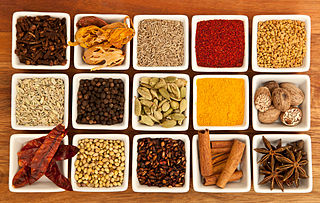 W
WMughlai cuisine consists of dishes developed in the medieval Indo-Persian cultural centres of the Mughal Empire. It represents a combination of cuisine of the Indian subcontinent with the cooking styles and recipes of Central Asian and Iranian cuisine. Mughlai cuisine is strongly influenced by the Turko-Persian cuisine of Central Asia, the region where the early Mughal emperors originally hailed from, and it has in turn strongly influenced the regional cuisines of modern Afghanistan, Northern India, Pakistan and Bangladesh.
 W
WAwadhi cuisine is a cuisine native to the Awadh region in Northern India. The cooking patterns of Lucknow are similar to those of Central Asia, the Middle East, and Northern India with the cuisine comprising both vegetarian and non-vegetarian dishes. The Awadh region has been greatly influenced by Mughal cooking techniques, and the cuisine of Lucknow bears similarities to those of Central Asia, Kashmir, Punjab and Hyderabad. The city is also known for its Nawabi foods.
 W
WDum pukht, larhmeen, or slow oven cooking is a cooking technique associated with the Northern Indian subcontinent in which meat and vegetables are cooked over a low flame, generally in dough-sealed containers with few spices. Traditions assign its origin in pre-partition India to the reign of Nawab Asaf-ud-Daulah (1748–97). The technique is now commonly used in other cuisines such as Pakistani and North Indian.
 W
WFalooda is an Indian version of a cold dessert made with noodles. It has origins in the Persian dish faloodeh, variants of which are found across West, Central, and South Asia. Traditionally it is made by mixing rose syrup, vermicelli, and sweet basil seeds with milk, often served with ice cream. The vermicelli used for preparing falooda is made from wheat, arrowroot, cornstarch, or sago.
 W
WHyderabadi cuisine, also known as Deccani cuisine, is the native cooking style of the Hyderabadi Muslims, and began to develop after the foundation of the Bahmani Sultanate, and more drastically with the Qutb Shahi dynasty around the city of Hyderabad, promoting the native cuisine along with their own. Hyderabadi cuisine had become a princely legacy of the Nizams of Hyderabad State, as it began to further develop further on from there. It is an amalgamation of Mughal, Turkish, and Arabic along with the influence of the native Telugu and Marathwada cuisines. Hyderabadi cuisine comprises a broad repertoire of rice, wheat and meat dishes and the skilled use of various spices, herbs and natural edibles.
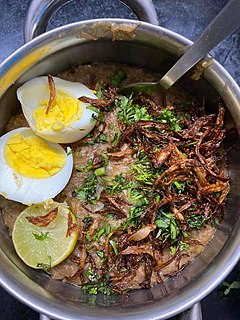 W
WHyderabadi haleem is a type of haleem popular in the Indian city of Hyderabad. Haleem is a stew composed of meat, lentils and pounded wheat made into a thick paste. It is originally an Arabic dish and was introduced to the Hyderabad State by the Chaush people during the rule of the Nizams. Local traditional spices helped a unique Hyderabadi haleem evolve, which became popular among the native Hyderabadis by the 19th century.
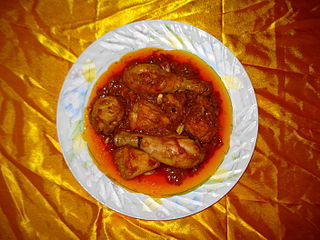 W
WKorma or qorma is a dish originating in the Indian subcontinent, consisting of meat or vegetables braised with yogurt (dahi) or cream, water or stock, and spices to produce a thick sauce or glaze.
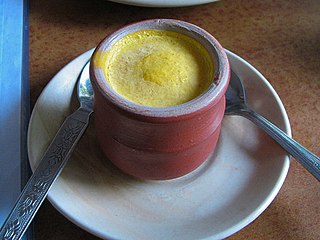 W
WKulfi or Qulfi (Bengali:কুলফি) is a frozen dairy dessert originating in the Indian subcontinent in the 16th century. It is often described as "traditional Indian ice cream". It is popular throughout India, Sri Lanka, Pakistan, Bangladesh, Nepal, Burma (Myanmar), and the Middle East, and widely available in restaurants serving cuisines from the Indian subcontinent around the world.
 W
WMughlai paratha is a popular Bengali street food which is believed to have originated in Bengal Subah during the time of Mughal Empire. The dish is believed to be prepared for the royal court of Mughal Emperor Jahangir. It can be a soft fried bread enhanced by a stuffing of keema, egg, onions and pepper; or a paratha stuffed with the same or similar ingredients.
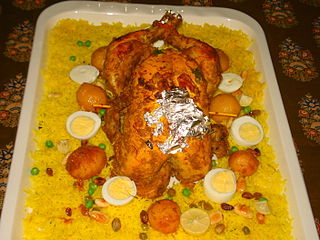 W
WMurgh musallam is a Mughlai dish originating from the Indian subcontinent. It consists of whole chicken marinated in a ginger-garlic paste, stuffed with boiled eggs and seasoned with spices like saffron, cinnamon, cloves, poppy seeds, cardamom and chilli. It is cooked dry or in sauce, and decorated with almonds and silver leaves.
 W
WNaan qalia is a dish that originates from Aurangabad, Maharashtra in India. It is a concoction of mutton and a variety of spices. Naan is a bread made in a tandoor, while qalia is a mixture of mutton or beef and various spices.
 W
WNihari is a stew from the Indian subcontinent consisting of slow-cooked meat, mainly shank meat of beef or lamb and mutton, goat meat and chicken, along with bone marrow.
 W
WPasanda is a popular meat dish from the Indian subcontinent, notably North Indian, Hyderabadi and Pakistani, derived from a meal served in the court of the Mughal emperors. The word is a variation on the Urdu word "pasande" meaning "favourite", which refers to the prime cut of meat traditionally used within.
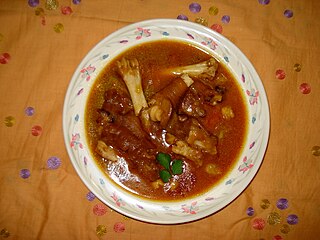 W
WPaya is a traditional food from the Indian Subcontinent.
 W
WRiti raita is a condiment in South Asian cuisine made of dahi together with raw or cooked vegetables, more seldom fruit, or in the case of boondi raita, with fried droplets of batter made from besan.
 W
WRogan josh, also written roghan josh or roghan ghosht, is an aromatic curried meat dish of Persian or Kashmiri origin. It is made with red meat, traditionally lamb or goat. It is coloured and flavoured primarily by alkanet flower or root and Kashmiri chilies. It is one of the signature recipes of Kashmiri cuisine.
 W
WRumali roti also called Manda is a thin flatbread originating from the Indian subcontinent, popular in India and in Punjab, Pakistan. It is eaten with tandoori dishes. The word rumal means handkerchief in many north Indian languages, and the name rumali roti means handkerchief bread. In Punjab, it is also known as lamboo roti. Lamboo simply means long in Punjabi. It is also known as dosti roti in the Caribbean.
 W
WShahi paneer is a preparation of paneer, native to the Indian subcontinent, consisting of a thick gravy of cream, tomatoes and Indian spices.
 W
WShami kabab or shaami kabab literally meaning "Syrian Kebab" is a local variety of kebab, originating from the Indian subcontinent. It is part of the cuisine of the Indian subcontinent and a popular dish in modern-day Indian, Pakistani and Bangladeshi cuisines. It is composed of a small patty of minced meat, generally beef, but occasionally lamb or mutton, with ground chickpeas, egg to hold it together, and spices. Shami kebab is eaten as a snack or an appetizer, and is served to guests especially in the regions of Dhaka, Deccan, Punjab, Kashmir, Uttar Pradesh and Sindh.
 W
WSharbat is an Iranian drink also popular in Turkey, South Asia, Caucasus and the Balkans. It is prepared from fruits or flower petals. It is a sweet cordial, and usually served chilled. It can be served in concentrated form and eaten with a spoon or diluted with water to create the drink. Popular sharbats are made of one or more of the following: basil seeds, rose water, fresh rose petals, sandalwood, bael, hibiscus, lemon, orange, mango, pineapple, falsa and chia seeds.
 W
WSheer khurma or sheer khorma is a festival vermicelli pudding prepared by Muslims on Eid ul-Fitr and Eid al-Adha in Afghanistan, Indian subcontinent and parts of Central Asia. It is a traditional Muslim festive breakfast, and a dessert for celebrations. This dish is made from various dry fruits, vermicelli, thickened milk, sugar etc. Depending on the region, cardamom, pistachios, almonds, cloves, saffron, raisins, and rose water are also added.
 W
WSheermal or Shirmal, is a saffron-flavored traditional flatbread from Greater Iran. The word sheermal is derived from the Persian words شیر meaning milk, and مالیدن meaning to rub. In a literal translation, sheermal means milk rubbed. After being introduced to North India by the Persianate Mughal emperors. It became a delicacy of Lucknow, Hyderabad and Aurangabad. It is also part of the Awadhi cuisine and is enjoyed in Old Bhopal and Pakistan.
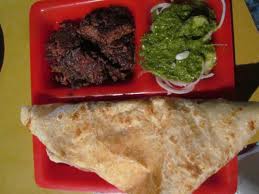 W
WTunde Ke Kabab, also known as Buffalo meat galouti kebab, is a dish made out of minced meat which is popular in Lucknow, India. It is part of Awadhi cuisine. It is said to incorporate 160 spices. Ingredients include finely minced buffalo meat, plain yogurt, garam masala, grated ginger, crushed garlic, ground cardamom, powdered cloves, melted ghee, dried mint, small onions cut into rings, vinegar, sugar, lime. Tunde ke kabab were introduced to the Nawab of Awadh Wajid Ali Shah. Lucknow’s iconic eating joint Tunday Kababi, started in 1905, is famous for serving buffalo meat galouti kebab.